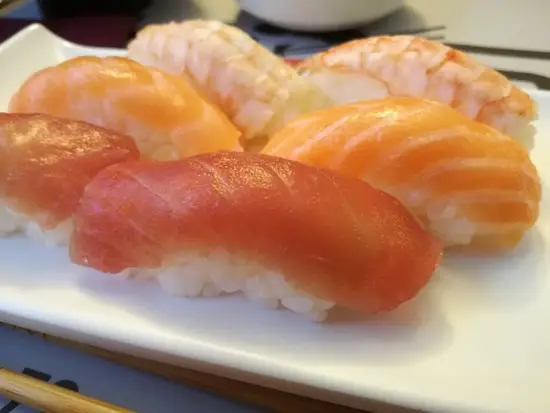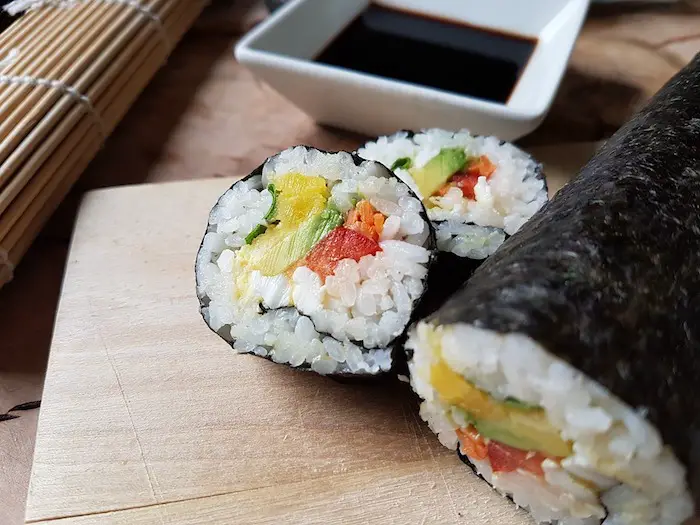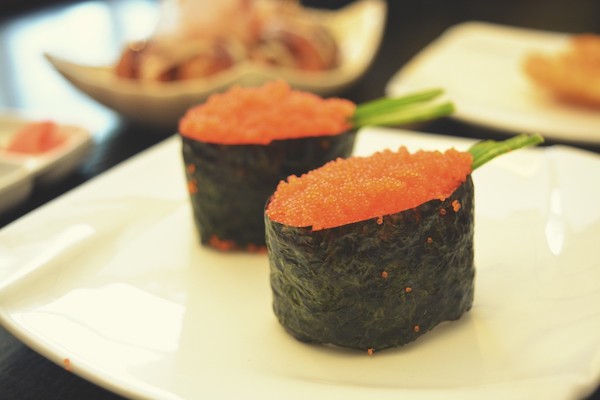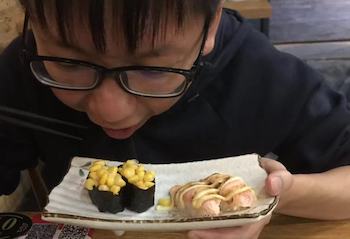We are reader supported. When you purchase through links on our site, we may earn an affiliate commission. Also, as an Amazon affiliate, we earn from qualifying purchases.

Sushi is an artistic and authentic Japanese cuisine that has become so common around the world that you can now find take-away packages in your local grocery store. Whether you choose to enjoy your sushi at an upscale restaurant, prefer a takeaway option, or have fun making it at home, here are a few things you should know about eating sushi.
Sushi is actually an umbrella term for different ways in which raw fish, vegetables, seasoned sushi rice, and seaweed are put together and served with soya sauce or wasabi sauce. There’s also a notable difference between Japanese sushi and western style sushi.
Today’s sushi has highly evolved from what it began originally. Sushi roughly means ‘sour’ and it started as a staple dish in various parts of Asia where fermented rice was used to preserve salted fish. The sushi as we know it today was developed by Hanaya Yohei and it uses fresh raw fish that was quickly prepared and meant to be eaten immediately.
While the Japanese sushi is less dressed and focused more on the quality of fish, their glamorous western counterparts focus more on rolls topped with sauces and garnishes. If you are new to sushi, you will be surprised to know that you can’t just go and ask for ‘sushi’ in a restaurant or sushi bar.
You will need to choose from the different varieties before ordering and you must know what they are before you order. Let me take you through the different varieties of sushi and familiarize you with the things that make them unique.
Contents
Different Types of Sushi
1. Sashimi
While these are often referred to
2. Nigiri

This is another unique style of sushi that looks different from the traditional form but still tastes great. It is made by rolling a ball of properly seasoned sushi and topping it with a succulent slice of sushi-grade raw fish. It is best eaten with your hands.
Related Article: Nigiri Sushi: All you Need To Know
3. Chirashi
Chirashi is a Japanese term that means scattered and in this style, you get vinegared sushi rice mixed with raw fish and several other delicious ingredients. It is quick to prepare and makes a tummy filling snack. The toppings in Chirashi may differ depending upon the region and availability of ingredients.
4. Maki

This is what you and I visualize when talking about sushi – the one made using a sheet of Nori seaweed with seasoned sushi rice, fish and vegetables inside it. A bamboo mat is used to roll up the sushi and each roll gives you 6-8 pieces of mouthwatering sushi. Maki sushi rolls may vary in style, ingredients, size, and taste.
Hosomaki is the most traditional style of making sushi with a sheet of Nori seaweed on the top and a layer of sushi rice inside it. It usually contains just one filling which may be of cucumber, carrots, or tuna fish.
Temaki is known as hand roll and it is prepared by layering the Nori sheet with sushi rice in half section and diagonally placing the vegetable and fish fillings. The Nori wrap is then folded in a cone shape just like ice-cream.
Futomaki is the fat sushi roll that contain a lot of ingredients inside such as vinegared sushi rice, 2-3 types of veggies, and raw fish rolled into a Nori seaweed wrap. The slices are large and filling.

Another popular type of Maki is Gunkan maki, also known as the battleship sushi. It is created by wrapping roasted seaweed around a ball of seasoned sushi rice in a way to create a well in between. Ingredients such as flying fish roe, sea urchin roe, oysters, or salmon roe are typically used to fill up the well.
What Are The Different Types Of Sushi Roll?
Sushi was first introduced to the USA in 1966 when a man named Noritoshi Kanai along with his partner Harry Wolff opened the first sushi restaurant in Little Tokyo in Los Angeles. This was the first time American patrons got to enjoy nigiri sushi outside Japan.
In 1970, the first sushi bar was opened in Hollywood and since then this Japanese delicacy has never looked back. Sushi chefs have highly evolved its taste, size, and variety to make them more appealing to the westerners and today we have an interesting fleet of sushi rolls that I would like to discuss today.
The biggest difference you will find between traditional
1. California Roll
This is one of the most popular westernized sushi roll typically made to visually appeal the Americans. It is also known as the inside-out sushi roll because of the method in which it is rolled. It has the sheet of Nori seaweed inside and sushi rice outside, just the opposite of traditional style. You may use fillings like cucumber, avocado, imitation crab, and other sushi-grade fish.
Related Article: How Long Do California Rolls Last In The Fridge?
2. Tempura Roll
Tempura Rolls are almost similar to a California Rolls as they have sushi rice layered atop the Nori seaweed. However, the fillings comprise tempura-fried shrimp with cucumber and avocado, hence the name!
3. Spicy Tuna Roll
The name itself can make your mouth water! In this delicious roll, you have sushi rice on the outside and Nori seaweed wrapped around juicy raw tuna mixed with delicious spicy mayonnaise. Hungry, anyone? See recipe in Just One Cookbook.
4. Dragon Roll
I love the name and trust me, it tastes superb! They are similar to Tempura Rolls as you have shrimp tempura, cucumber, and avocado, as fillings. A layer of sushi rice (sprinkled with toasted sesame seeds) over the Nori holds the ingredients inside. The name ‘dragon’ comes from the way thin slices of avocado are adorned over the slices. Tastes best with soya sauce or mayo.
I just wrote the best dragon roll recipe, click here to have a look at it.
5. Spider Roll
If you love crabs, these are to die for! The specialty about Spider Rolls is that they contain deep-fried crabs wrapped with Nori seaweed and seasoned sushi rice. They may also contain other ingredients such as avocado, cucumber, lettuce, daikon sprouts, raw fish, and spicy mayonnaise. See Spider Roll Recipe | Food Network
What’s The Right Way To Eat Sushi
Sushi originated in Japan. True! The Japanese eat sushi using chopsticks effortlessly – right! However, that does not mean you cannot eat sushi with your hands. If you are a non-Japanese and find difficult to use chopsticks, it’s perfectly alright. You don’t have to feel embarrassed about eating sushi with your hands. In fact, nigiri is meant to be eaten with hands so that you don’t spoil the perfect form.
If you have to use chopsticks, use the back end to pick your piece from a shared plate. I would suggest you to try eating sashimi using chopsticks as this is easier with no-mess. Dip one side of the raw fish in soya sauce and relish the juicy and soft taste in your mouth.
When eating sushi rolls containing seasoned sushi rice, make sure you only dip the fish side of roll in the sauce. The rice is already seasoned and the chef sprinkles just the right amount of soya sauce to it, so go with what the chef has served you. Your taste buds will love you for this!
Resist the temptation of mixing the pickled ginger with soya sauce. It should be eaten only as a palate cleanser between eating sushi pieces. It also works as a wonderful digestion aid, so eat it the way it’s meant to be.
Eat your sushi is one go instead of biting it into the half. This is considered disrespectful in a sushi bar or restaurant where a chef painstakingly created a perfect piece. If you feel the sushi size is too big for you to eat in one bite, tell the chef to adjust the proportion for you.
If you ordered miso soup with sushi, it’s perfectly fine to drink it from the bowl. Furthermore, miso is not an appetizer. It is supposed to be relished after the main course.
Tips For Choosing A Sushi Restaurant
So you ate sushi in Japan or at a Japanese friend’s house and now you are craving to indulge in the delicacy again. Well, you need to make the right choice when eating sushi out of Japan to guarantee a perfect experience. Here are a few guidelines to remember before heading to any sushi restaurant or bar.
- If you are new to sushi eating, I would recommend that you ask the experts or check customer reviews on Yelp or similar sites before choosing a restaurant. Remember that price is not always an indicator of good quality. Sometimes you may not get good sushi at a posh restaurant while a small Japanese eatery may serve you lip-smacking treat.
- Stay away from “all you can eat” type of sushi restaurants no matter how tempting the offer seems to you. Good sushi is prepared with care and precision, which is not possible when the chef is churning out sushi-like cookies in bulk quantity.
- A good sushi restaurant will not shy away from serving raw fish. If most of the items in the menu contain cooked fish instead of raw then chances are the fish is old or poor quality. I would recommend that you stay away from such places.
- When sushi is made fresh, the rice will be at room temperature or body temperature. If it the rice feels colds, it’s a good indicator that the sushi is not freshly made and has been sitting in the refrigerator for a long time.
- Related article: Can You Leave Sushi Rice Overnight?
- If the Nori seaweed wrap feels moist or soggy, this means the sushi is not fresh. When a chef makes sushi in front of your eyes, this is the freshest quality. You will know it instantly because the Nori will have a crisp texture with a toasty flavor and the raw fish will melt in your mouth.
- The presentation speaks a lot about how serious the sushi chef is about his creation. A really passionate chef will present his craft in a visually appealing manner. If the sushi plate does not look well organized or attractive, it’s probably not the best place to eat sushi.
- A good sushi restaurant will have knowledgeable staff that knows the menu like the back of their hand and even help you with the order. They will also be able to answer your questions. I recommend eating sushi in a trusted sushi bar where the chef prepares his craft right in front of your eyes.
- Besides the look and taste of sushi on your plate, the smell of the place also tells a lot about a restaurant. It’s true that sushi contains raw fish in it, but the restaurant should not smell like it. A world popular sushi chef once said that a good sushi restaurant should smell of cucumbers and watermelon, not fishy!
Six Common Mistakes To Avoid When Eating Sushi
Do you want to eat sushi like a pro? Then you must know the things connoisseurs will never do when eating sushi. I know many of us are guilty of a few things below, so let’s take a look and pledge not to commit those mistakes again
#1. Adding extra wasabi to your sushi
The chef already adds the right amount of wasabi to your sushi before serving it to you. Some people insist on adding more wasabi to the sushi on their plate. Trust me, this can totally spoil the taste. Even the slightest amount of extra wasabi can make your sushi too spicy to enjoy! So taste one piece first and then decide whether you need to add more wasabi or not.
#2. Dipping sushi rice into soy sauce
Oh! What’s wrong with people? I see this happening now and again. People try to dip sushi rice inside soy sauce and lose delicious rice into a pool of sauce! Please do yourself a favor and dip only the fish part, never the rice. Your chef has probably drizzled some soy sauceon it anyway so adding more sauce will only make rice absorb more sauce thanneeded.
#3. Leaving chopsticks sticking out of the rice bowl
If you are eating at a Japanese restaurant, it pays to know the culture and avoid hurting traditional sentiments. Leaving chopsticks sticking out of rice bowl is disrespectful as it resembles the way incense sticks are kept in funerals. You must also avoid rubbing the chopsticks together as this will cause them to break and indicate that the utensils served are cheap.
#4. Eating rolls before sashimi and sushi
When you are in a sushi restaurant, follow this rule – always order sushi and sashimi before the rolls. Sashimi is supposed to be the appetizer that comes first and should be small in size. Ask your server to help you with this if you are new to sushi eating.
#5. Eating sushi like a piece of burger
You are eating sushi, not a burger so avoid cramming it up with ten different ingredients. Massive sushi rolls don’t exist in Japan and this is a complete non-traditional take on the delicacy. Sushi is meant to honor the flavor of each ingredient, so lesser is better.
#6. Brown rice in sushi
I know the fitness freaks swear by brown rice and would avoid anything that has carbs in it. But, come on, you are eating sushi to enjoy a traditional delicacy. Without the sticky white rice, sushi will just not taste the same. Brown rice has a chewier feel to it while sushi rice is supposed to melt in your mouth! If you are interesting about how to make sushi rice more sticky, you can have a look my previous article: here
The Final Words
If you love sushi, you must appreciate the tradition and the right way in which it is meant to be eaten. I personally believe you should stick to the traditional Japanese style to enjoy a perfect sushi experience. While slight changes to the recipe suit your personal style when you are preparing sushi at home may be fine, make sure you season the rice well, use sushi-grade fish, and keep ingredients to 2 or maximum 3 to avoid overpowering the taste.
Knowing your sushi well will not only help you become a great chef at home but also enable you to make the most of your dining experience at a sushi restaurant. So, are you ready for a



Comments
Pingback: Difference Between Japanese Sushi And American Sushi - Easy Homemade Sushi
Pingback: What Do Sushi Chefs Say When You Enter? - Easy Homemade Sushi